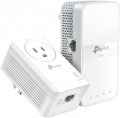Wi-Fi standards supported by the adapter.
Wi-Fi technology allows you to use the adapter as a wireless access point for laptops, smartphones, tablets, etc. Also, many models are able to work in Wi-Fi clone mode, repeating the signal of a router already on the network and expanding its range. And different Wi-Fi standards differ in maximum data transfer rate and frequency range:
- — Wi-Fi 1 (802.11b). Has a theoretical maximum speed of 1 Mbps, uses a frequency of 2.4 GHz;
- — Wi-Fi 3 (802.11g) — speed up to 54 Mbps, frequency 2.4 GHz;
- — Wi-Fi 4 (802.11n) — speed up to 600 Mbps, frequency 2.4 GHz or 5 GHz;
- — Wi-Fi 5 (802.11ac) — speeds up to 6.77 Gbps, frequency 5 GHz.
- Wi-Fi 6 (802.11ax). A version with increased speed up to 10 Gbps and important improvements in the format of work. One of the most important innovations is the use of an extensive frequency range - from 1 to 7 GHz; this, in particular, allows you to automatically select the least loaded frequency band, which has a positive effect on the speed and reliability of the connection. At the same time, Wi-Fi 6 devices are capable of operating at the classic frequencies of 2.4 GHz and 5 GHz. In addition, some improvements were introduced in this version regarding the simultaneous operation of several devices on one channel, in particular, we are talking about OFDMA technology. Thanks to this, Wi-Fi 6 gives the smallest speed drop among m
...odern standards when the air is loaded.
Note that the data transfer rate is an perfect theoretical indicator; in fact, it is usually several times lower.
The described standards are mutually compatible if they coincide in operating frequencies (unless the speed of operation will be limited by the slowest device). Thus, the 802.11ac standard is practically not used in its pure form — it is supplemented at least with support for 802.11n.Wi-Fi frequency bands in which the adapter operates. This setting is directly related to supported Wi-Fi standards (see above). However, individual ranges have their own common features that are not dependent on standards.
-
2.4 GHz. The most popular band supported by both the latest and legacy wireless equipment. At the same time, this frequency is popular not only in Wi-Fi modules, but also in other devices (Bluetooth communication, microwave oven generators, etc.), which leads to quite a lot of interference and increases the likelihood of communication problems.
-
5 GHz. The 5 GHz band allows to achieve higher data rates than 2.4 GHz; in addition, it is less loaded with interference. Therefore, support for this frequency is increasingly found in modern Wi-Fi devices (though most often in addition to the 2.4 GHz band, which allows you to work with older devices).

